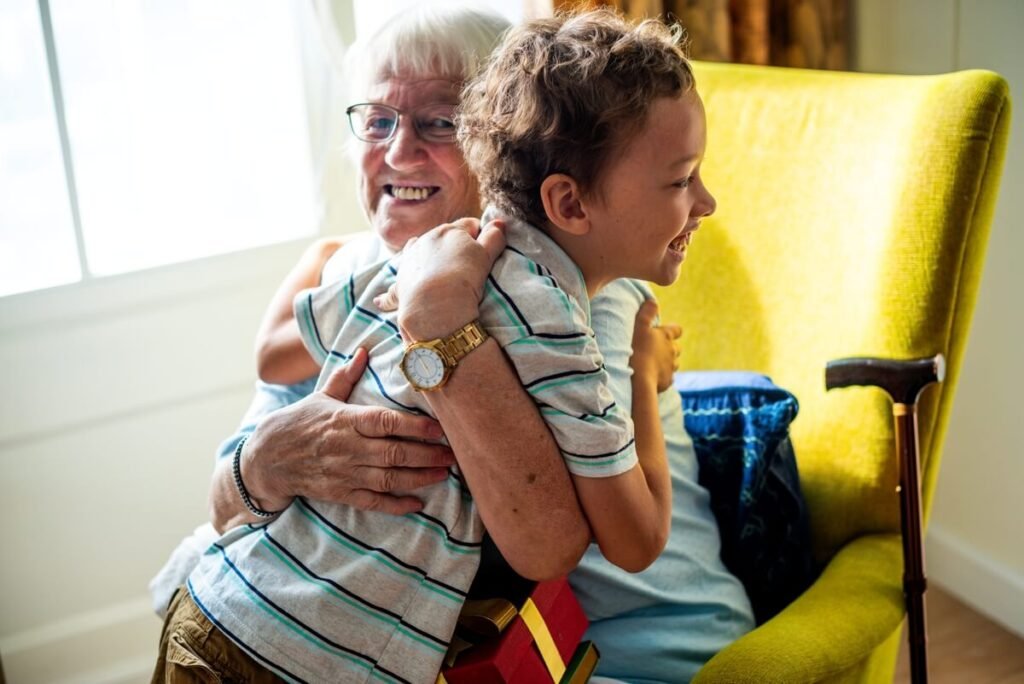Reducing Family Caregiver Stress One Hug at a Time

I come from a long line of huggers. It’s a family thing.
There’s just something about a warm embrace or a simple touch that’s often hard for me to explain or quantify. When I was a child, my parents taught me about the Biblical story of Jesus and the leper who wanted to be healed. Jewish law at the time required that the sick man call out that he was “unclean,” or contagious, and that people should avoid him.
According to the Gospel account, Jesus not only healed him, but he also defied the man’s expectations by touching him. I can only imagine that man’s experience: That touch may have been the first touch from another human that he’d had in a very long time!
Maybe there’s a lesson we can infer from that?
The Family Caregiver’s Hug: Maria’s Story
Maria had been caring for her aging mother for over a year. While she loved her mother deeply, the stress often left her feeling worn out and disconnected. One morning, after a sleepless night, Maria leaned in and gave her mother a long hug. To her surprise, her mother smiled and said, “I needed that.”
That moment changed everything.
Maria started giving her mom a gentle hug each morning and before bed. Over time, she noticed a shift not only in her mother’s mood, but in her own. She felt calmer, more connected, and less alone. Hugging became their quiet way of saying, “We’re in this together.” That’s when Maria realized: sometimes, healing doesn’t come from a pill or a plan. It comes from a simple embrace.
Family caregiving is full of love, but it can also be overwhelming. What if something as simple as a hug could help? Hugging is more than a friendly gesture. It’s a powerful tool for healing.
In caregiving, hugging can support both the caregiver and the person receiving care. In this post, we’ll explore how hug therapy can help reduce caregiver stress and boost emotional well-being.
Why Hugging Matters in Family Caregiving
The Science Behind a Simple Hug
When you hug someone, your body releases a hormone called oxytocin. This hormone is known as the “love hormone.” It helps you feel close and connected. At the same time, hugging lowers levels of cortisol. That’s the hormone linked to stress. This combination helps the body relax. In fact, just a 20-second hug can lower your heart rate and blood pressure.
Emotional Connection Through Touch
Caregiving isn’t only about giving medication or helping with meals. It’s also about emotional support. A hug can say, “I see you,” or “You’re not alone.” This kind of physical touch helps the caregiver and the loved one feel supported. In tough moments, it can be a quick way to bring calm and connection.
Healing for Both Sides
Hugging works both ways. When a caregiver hugs a loved one, both people benefit. The caregiver may feel more grounded, less anxious, and more appreciated. The person receiving care often feels safer and more loved. This shared experience helps build trust and makes daily caregiving tasks feel less heavy.
How Hug Therapy Helps in Reducing Caregiver Stress
Quick Stress Relief You Can Feel
Caregivers often carry stress in their bodies. Tight shoulders, headaches and fatigue are common. Hug therapy gives the body a chance to reset. Oxytocin not only makes people feel good, it also helps relax muscles and calm the nervous system. In moments of burnout, a single hug can ease both mind and body.
Read more about the potential effects of caregiver stress.
Improves Mood and Mental Health
Long hours of caregiving can take a toll on mental health. Hug therapy increases the release of “feel-good” chemicals like serotonin and dopamine. These help lift mood and reduce feelings of sadness or frustration. Caregivers who make hugging part of daily care often feel more hopeful and emotionally strong.
Boosts Physical Health for Caregivers
Ongoing stress can hurt the immune system. Hugging, on the other hand, may help it. Studies show that people who get more hugs are less likely to get sick. For caregivers, who often skip self-care, a simple hug is one way to protect both their emotional and physical health.
Hugging as a Communication Tool in Caregiving
When Words Fall Short, Hugging Speaks
There are times when talking just isn’t enough. Maybe your loved one has dementia or is non-verbal. A hug can bridge that gap. It tells them you care, without saying a word. It brings warmth, comfort and reassurance when language isn’t possible.
Strengthens Trust and Bonding
Caregiving can sometimes create emotional distance, especially when the caregiver feels stressed. Hugging helps restore closeness. Regular hugs build trust. They remind both people that their relationship is more than the tasks. They’re still connected as family or loved ones.
Encourages Openness and Safety
A hug can make it easier for someone to talk about their fears or needs. It creates a safe space where emotions can be shared. For caregivers, this means better communication and fewer misunderstandings. When people feel safe, they’re more likely to cooperate with care routines.
Simple Ways to Add More Hugs to Your Caregiving Routine

Set a “Hug Goal” for the Day
Experts suggest setting a goal for how many hugs you give each day. Start small. Maybe four hugs a day. From there, work your way up to eight or even twelve hugs a day. These regular moments of contact can make a big difference in your stress levels. Write it on a sticky note or set a reminder on your phone to help make it a habit.
Use Hugs to Start and End the Day
Begin and finish your caregiving routine with a hug. Morning hugs help start the day with warmth and support. Evening hugs bring comfort and a sense of calm before rest. These daily touchpoints can improve your mood and create emotional stability for both of you.
Respect, Comfort and Consent
Always ask before giving a hug. Some people may not feel comfortable with close touch. That’s okay. A gentle hand on the shoulder or holding hands can offer similar comfort. The goal is connection, not pressure. When both people feel safe, the hug becomes more powerful.
The Bottom Line: Small Hugs, Big Healing
Caregiving is a journey filled with love, but also stress and hard work. Hug therapy is a simple, powerful way to ease that stress. Hugs bring emotional relief, boost health and deepen your bond with the person you care for. Whether it’s one hug or twelve, each one helps.
If you’re a family caregiver, start adding hugs into your day. Notice the change in how you feel and how your loved one responds. Sometimes, the smallest actions carry the greatest healing power.
Take Action: Try giving at least four hugs today. See how it feels. Share this idea with others in your caregiving circle. Together, you can turn simple hugs into a powerful wellness habit.
Caregiver Hugging FAQ
What is hug therapy in caregiving?
It’s the use of warm, caring hugs to improve emotional and physical well-being. In caregiving, it helps reduce stress, build trust and offer comfort to both the caregiver and the person receiving care.
How many hugs should a caregiver aim for each day?
Experts suggest starting with four hugs per day. Eight hugs support emotional balance, and twelve hugs can help with deeper connection and happiness.
Can hugging improve my mood as a caregiver?
Yes. Hugs release hormones like oxytocin, serotonin and dopamine. These chemicals help reduce anxiety and improve your mood, making you feel more positive and calm.
What if my loved one doesn’t like to be hugged?
Always respect others’ personal space. Some people prefer a gentle hand on the back, holding hands or just sitting close. What matters most is the feeling of connection and care.
Can hugging really make a difference in long-term caregiving?
Yes. When done regularly, hugging can help lower stress, improve health and strengthen relationships. It’s a small act with big impact over time.






